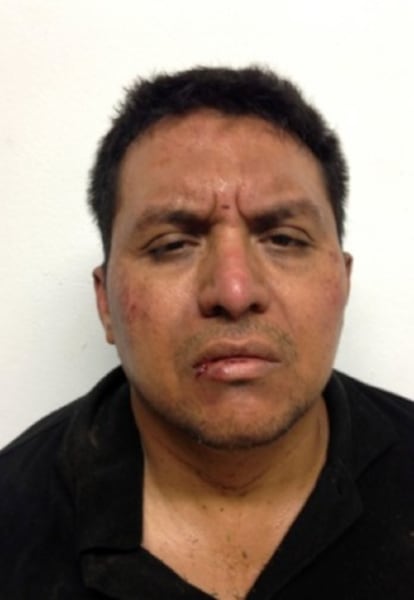Brutal leader of Zetas cartel is captured
Arrest marks first major success against drug gangs for Peña Nieto

Miguel Ángel Treviño Morales, the man known as Z-40 and the leader of Los Zetas, the bloodiest drug cartel in recent memory, was apprehended on Monday by the Mexican Navy in Nuevo Laredo, along the border with the United States. His arrest is the first major success by the Enrique Peña Nieto administration against the drug syndicates, and it comes at a time when questions were arising over the efficiency of his new security strategy. It is also a huge blow – possibly a definitive one – to a gang of traffickers who have been going downhill ever since the death of their previous boss, Heriberto Lazcano Lazcano, in October of last year.
At the time of his arrest, Treviño was traveling in an all-terrain vehicle with two other passengers, who were also taken into custody. Eight shotguns and two million dollars in cash were found in the trunk of the car.
Z-40 was born in 1973 in Nuevo Laredo, a bastion for the Zetas gang for over a decade. He came from a family of 13 siblings, of whom at least six have been involved in organized crime. He climbed to the top of the criminal ladder thanks to his reputation for sadistic violence, and stepped into Lazcana’s seat when the latter was killed by government forces. Some of the charges he faces include the kidnapping and assassination of 265 migrants in San Fernando (Tamaulipas).
He began his long criminal career as a teenager, and spent some time in Dallas (Texas). Treviño joined the Zetas soon after the creation of the cartel by a group of deserters from the Mexican army’s special forces in the late 1990s. The group operated as the armed branch of the Cartel del Golfo. He was in fact one of the few Zetas leaders with no military experience, but by 2005 he had become the lord of Nuevo Laredo. Like so many other kingpins, he had expensive tastes and liked fast cars, horses and wild animals, which he shipped in from Africa. But what he was really known for was his brutality: he was fond of eliminating his enemies by dismembering them and burning them alive. The United States’ Drug Enforcement Administration (DEA) was offering a $5-million reward for his capture.
Treviño came from a family of 13 siblings, of whom at least six have been involved in organized crime
But the break-up between the Cartel del Golfo and the Zetas in 2010 led to much bloodshed in northeastern Mexico. The Zetas’ victory encouraged them to try to wrest control of the border drug trade from the Sinaloa cartel, led by Joaquín el Chapo Guzmán. The orgy of violence got even worse when in 2011 the Zetas descended into civil strife after Lazcano and Treviño became enemies. In the end, Treviño managed to overcome those who were against him and take full control of the group. Some investigators say that as many as 14 bosses were liquidated during this period of internal warfare.
Despite their violence, some analysts believe that the Zetas never really managed to take over the drug business from the Sinaloa cartel, which is why they turned to other criminal activities such as people trafficking, kidnapping, extortion and even oil theft.
The bloodless arrest of Z-40 is also in stark contrast with the way the Mexican government has dealt with drug gangs over the last six years. Under the former president, Felipe Calderón, leaders were gunned down. Such was the end of Arturo Beltrán Leyva, who died in a shootout in Cuernavaca in December 2009. In July 2010, Ignacio “Nacho” Coronel, a leading member of the Sinaloa cartel, was killed by soldiers who stormed the house where he was staying. The most recent case was that of Heriberto Lazcano, then the Zetas leader, who died as he tried to flee from a Navy patrol. His body was stolen from the funeral home by the Zetas, and there has been some speculation as to whether he is really dead at all.
Tu suscripción se está usando en otro dispositivo
¿Quieres añadir otro usuario a tu suscripción?
Si continúas leyendo en este dispositivo, no se podrá leer en el otro.
FlechaTu suscripción se está usando en otro dispositivo y solo puedes acceder a EL PAÍS desde un dispositivo a la vez.
Si quieres compartir tu cuenta, cambia tu suscripción a la modalidad Premium, así podrás añadir otro usuario. Cada uno accederá con su propia cuenta de email, lo que os permitirá personalizar vuestra experiencia en EL PAÍS.
En el caso de no saber quién está usando tu cuenta, te recomendamos cambiar tu contraseña aquí.
Si decides continuar compartiendo tu cuenta, este mensaje se mostrará en tu dispositivo y en el de la otra persona que está usando tu cuenta de forma indefinida, afectando a tu experiencia de lectura. Puedes consultar aquí los términos y condiciones de la suscripción digital.








































